GIGABYTE Server GA-7PESH3 Motherboard Review
by Ian Cutress on September 4, 2014 2:00 PM EST- Posted in
- Motherboards
- Intel
- Gigabyte
- Xeon
- Workstation
- Enterprise
- C602
CPU Benchmarks
Readers of our motherboard review section will have noted the trend in modern motherboards to implement a form of MultiCore Enhancement / Acceleration / Turbo (read our report here) on their motherboards. This does several things, including better benchmark results at stock settings (not entirely needed if overclocking is an end-user goal) at the expense of heat and temperature. It also gives in essence an automatic overclock which may be against what the user wants. Our testing methodology is ‘out-of-the-box’, with the latest public BIOS installed and XMP enabled, and thus subject to the whims of this feature. It is ultimately up to the motherboard manufacturer to take this risk – and manufacturers taking risks in the setup is something they do on every product (think C-state settings, USB priority, DPC Latency / monitoring priority, memory subtimings at JEDEC). Processor speed change is part of that risk, and ultimately if no overclocking is planned, some motherboards will affect how fast that shiny new processor goes and can be an important factor in the system build.
Point Calculations – 3D Movement Algorithm Test: link
3DPM is a self-penned benchmark, taking basic 3D movement algorithms used in Brownian Motion simulations and testing them for speed. High floating point performance, MHz and IPC wins in the single thread version, whereas the multithread version has to handle the threads and loves more cores.
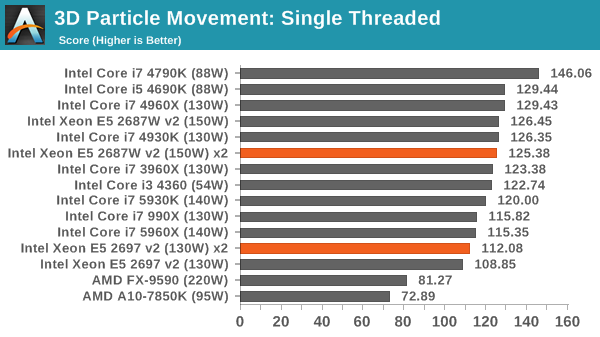
The single threaded test should be limited by the linear code, and we see in both dual CPU configurations it performs similarly to the single CPU result.
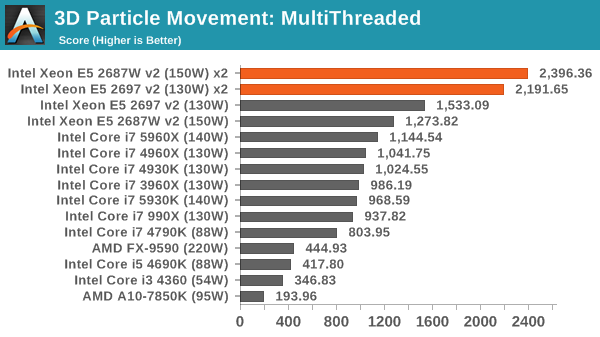
As the 3DPM algorithm involves no core-to-core data transfer, the 2P system can show its legs. Here the faster eight-core beats the slower 12-core.
Compression – WinRAR 5.0.1: link
Our WinRAR test from 2013 is updated to the latest version of WinRAR at the start of 2014. We compress a set of 2867 files across 320 folders totaling 1.52 GB in size – 95% of these files are small typical website files, and the rest (90% of the size) are small 30 second 720p videos.

WinRAR can take advantage of many threads in a system, however a 2P system presents some difficulty in managing that data. WinRAR also likes fast memory, and so as a result the single eight core 5960X can get a better result than any of our 2P configurations.
Image Manipulation – FastStone Image Viewer 4.9: link
Similarly to WinRAR, the FastStone test is updated for 2014 to the latest version. FastStone is the program I use to perform quick or bulk actions on images, such as resizing, adjusting for color and cropping. In our test we take a series of 170 images in various sizes and formats and convert them all into 640x480 .gif files, maintaining the aspect ratio. FastStone does not use multithreading for this test, and thus single threaded performance is often the winner.
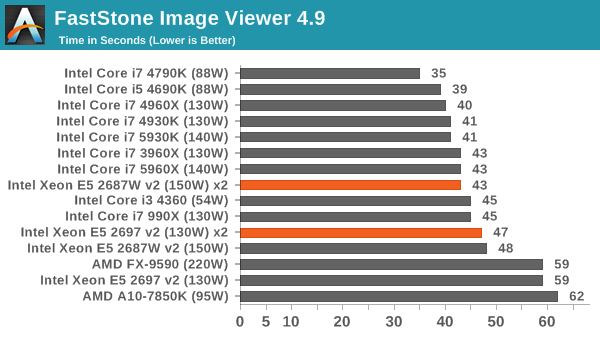
Video Conversion – Handbrake v0.9.9: link
Handbrake is a media conversion tool that was initially designed to help DVD ISOs and Video CDs into more common video formats. The principle today is still the same, primarily as an output for H.264 + AAC/MP3 audio within an MKV container. In our test we use two videos: a 640x266 2h20 film rip and a double UHD 10 minute animation short. Results are given in frames per second.
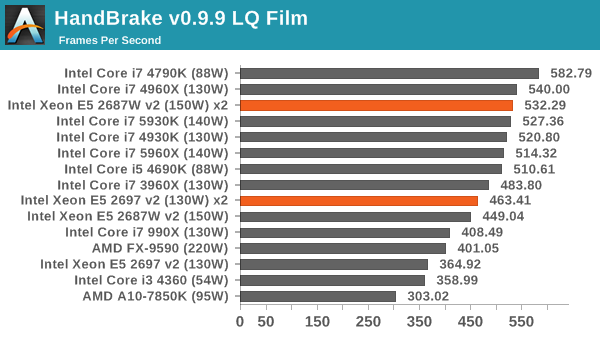
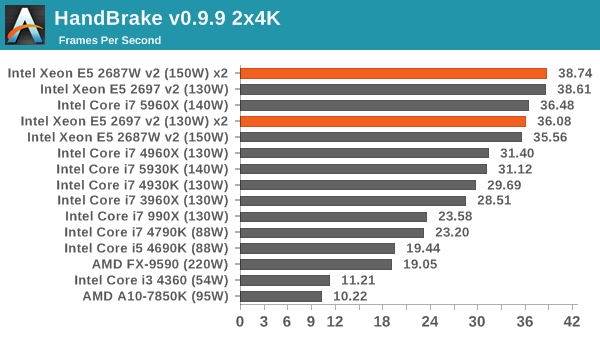
One would imagine that Handbrake could take advantage of all the extra cores on hand. For the LQ film, this is true at least for the faster frequency E5-2687W v2 model, however in 4K transcoding the data transfer between the CPUs becomes a bottleneck over raw CPU performance.
Rendering – PovRay 3.7: link
The Persistence of Vision RayTracer, or PovRay, is a freeware package for as the name suggests, ray tracing. It is a pure renderer, rather than modeling software, but the latest beta version contains a handy benchmark for stressing all processing threads on a platform. We have been using this test in motherboard reviews to test memory stability at various CPU speeds to good effect – if it passes the test, the IMC in the CPU is stable for a given CPU speed. As a CPU test, it runs for approximately 2-3 minutes on high end platforms.
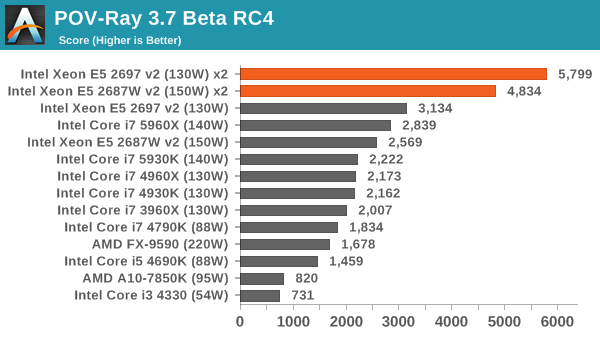
POV-Ray indicates more of what a 2P system should show: raw power. Here cores win out over frequency.
Synthetic – 7-Zip 9.2: link
As an open source compression tool, 7-Zip is a popular tool for making sets of files easier to handle and transfer. The software offers up its own benchmark, to which we report the result.
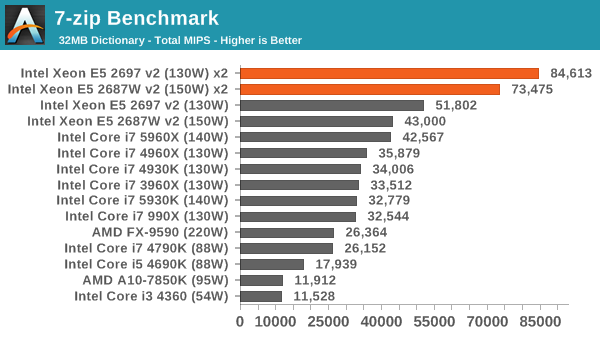










35 Comments
View All Comments
tuxRoller - Thursday, September 4, 2014 - link
So, you've got a workstation class board but are running Windows 8...Is it so difficult to throw centos on there for the benefit of those working at Pixar?
MrSpadge - Friday, September 5, 2014 - link
Those working at Pixar likely won't need an Ivy-EP review. Apart from that.. I'm sure Ian is glad not to have to deal with CentOS :ptuxRoller - Friday, September 5, 2014 - link
Centos is easy to setup, and the new release is quite nice.My point with Pixar was that there are many serious creators who use Linux workstations, and not just for simulations. Unless you work in the area it's possible you may not know the prevalence of Linux among workstations, especially relative to windows 8, in my experience.
That aside, seeing the comparative performance numbers of the two OS's is useful to get an idea of what the hardware itself can do.
mpbrede - Friday, September 5, 2014 - link
I really hope that this crappy grammar is just an indication of haste and not of lower editorial standards now that Anand has left the room."As a result, gaming often sees a hit in performance, as well as basic tasks." -> ...result, gaming, as well as basic tasks, sees a hit...
"Interestingly GIGABYTE does not supply any extra power connectors for these PCIe slots, indicating that not each port might not be able to provide 75W when all are populated (e.g. seven graphics cards)." -> read it slowly, how many "nots" should there be in a single sentence?
aryonoco - Friday, September 5, 2014 - link
A server/workstation motherboard requires its own benchmarks.For anyone who is in the target market of this product, this review is absolutely worthless. Gaming benchmarks? Really?!
colonelclaw - Friday, September 5, 2014 - link
Thanks for the review. In the future please consider including the following benchmarks:3DSMax + Vray, Maya + VRay/Arnold/Renderman, Adobe Media Encoder, Adobe After Effects, Adobe Premiere Pro. Some VRay RT and Octane multi-GPU benchmarks would be a nice addition, too.
The one thing I find slightly strange about this motherboard is the low number of memory slots. All our DP motherboards have twice as many per processor (and many are full). I wonder why Gigabyte decided on just eight?
eanazag - Friday, September 5, 2014 - link
I think the point of making the board where the CPUs line up was to allow better airflow to the add-on cards (GPUs). Lining up the CPUs didn't allow for the normal # of mem. slots.In actuality I would think most buyers of this board would just go with one CPU. It allows for the video compute cards to have more juice from the ATX 24 pin. I have bought 2P boards for one proc because of the peripheral items like slots, networking, RAID, and built-in network management. When you look at non-server boards and add the pricing of add-on management it starts to make you consider the server/workstation board.
The Von Matrices - Friday, September 5, 2014 - link
The reason for this is because Gigabyte chose to use square ILM sockets.For those who do not know, LGA2011 has two sockets - square ILM and narrow ILM. Most consumer motherboards use the square ILM sockets; you only see the narrow ILM sockets in servers. The narrow ILM socket is obviously narrower, which allows more memory slots on the same size motherboard. The disadvantage of the narrow ILM socket is that the memory slots are so close to the processor that large and quiet tower heatsinks can't be used since they cover the closest memory slots.
Basically, when designing a dual LGA2011 SSI CEB motherboard, you have to choose two of the three following features:
16 DIMM slots
7 PCIe slots
Square ILM sockets
If you use 16 DIMMs and 7 PCIe slots, you have to use narrow ILM sockets, which eliminates the use of tower heatsinks.
If you use 7 PCIe slots and square ILM sockets (like Gigabyte did) you now can use tower heatsinks. However, then there is only enough space on the motherboard for 8 or 12 DIMM slots.
If you use 16 DIMMs and square ILM sockets, there's only enough space on the motherboard for 6 PCIe slots.
joannecdinkins - Friday, September 5, 2014 - link
just as Larry answered I didnt even know that people able to get paid $6104 in a few weeks on the internet .go to this site>>>>> paygazette.ℭOM
KAlmquist - Friday, September 5, 2014 - link
One thing that's not addressed in this review is whether it makes sense to run Windows 7 on a multi-socket system. The benchmarks showing dual E5-2687W processors running significantly slower than a single E5-2687W suggest that Windows 7 is making bad scheduling decisions. Would Windows Server or Linux do better?Let me explain my point about scheduling decisions in a bit more detail. If you run a piece of software on a system with a single processor, the operating system has to make decisions about when to run each thread, and which core to run it on. Now switch to a system which is similar to the first system except that it has two processors. If the operating system simply ignores the second processor, and makes the same scheduling decisions as it made on the first system, then the performance of the two systems should be quite close. I'm not suggesting that this approach to scheduling on a dual processors system makes sense, but it is a possible approach. So if the approach to scheduling used by Windows 7 results in even worse performance, we know that Windows 7 could do better. In fairness to Microsoft, Windows 7 is not marketed as a server OS, so maybe it shouldn't be expected to perform well on server hardware.